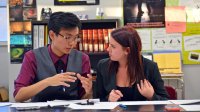Student-Centered Advisory: Establishing a Positive Community
Advisory groups are “school families” that give students a time block to focus on schoolwork, college applications, personal issues, or hearing and respecting one another.
Last month, I was lucky enough to travel to the Dynamic Landscapes conference in Burlington, Vermont, to run a workshop about student-centered advisory. As often happens when you put a group of forward-thinking and passionate educators in a room, we had some great discussion about how we do advisory in our schools and with our students. And, as often happens, I learned a lot about my own approach to my advisory through this discussion.
What Is a Student-Centered Advisory?
The first thing we had to do as a group was define what advisory actually is. The group came up with words like community, goals, connections, fun, support, and sharing. As for the role of advisory, we proposed things like guiding force, safe space, and advocate. These powerful words define a space that an advisor and students build together. It's also very different from the way that many advisories are structured.
With these terms in mind, it becomes easier to define what a student-centered advisory actually is. In a student-centered classroom, learning is less teacher-directed and is instead guided by student interests and fueled by student questions. In advisory, this is the difference between a curricular framework and the curriculum binder that many advisors are given. If we are charged with supporting, guiding, advocating for our students, building community, and helping our students set and achieve goals, then a scripted lesson plan will not get us there. Advisory is messy. It's unpredictable, it's some of the hardest work you may ever do, and it can be unbelievably rewarding.
What Does a Student-Centered Advisory "Teach?"
My own experience with advisory is with my students at Science Leadership Academy at Beeber. Despite the messiness, there are certain soft skills that we advisors want our students to learn. We also know that certain skills and strategies are important to learn at particular times in a student's academic career. Needs and questions arise from both students' and advisors' day-to-day experiences, and sometimes these conversations supersede any planned activity or lesson. These breaks from curriculum and the lesson plan are key to a student-centered advisory. Fluidity in content also means that no one advisory looks like another. Each is a unique set of personalities with a unique set of needs. Even within an advisory, there are common threads, but every student comes to the table with a different skillset and different areas in need of growth, and each advisor has his or her own approach to working with an advisory family.
So what does a student-centered advisory look like on any given day? Some days, it means that there's a structured activity or assignment. For my juniors this past year, these activities were mostly based around the college application process. For freshmen, it may be centered around time management or communicating with their teachers. Other days, I have an activity planned, but during our check-in at the beginning of the period, it becomes clear that we need to have an entirely different conversation based on student concerns or questions. And yes, on other days, it's a birthday party or "work on whatever big project you have coming up" time. During advisory, I may also check in with specific students about their grades (all students submit grade check-ins weekly so that I can see how they're doing), or about a concern that they have in a class. I may also spend time talking with a student about something completely non-academic that's on his or her mind. With 40 minutes twice a week, this time is fleeting, so sometimes I also need to meet with kids outside of regular advisory periods.
Building Relationships
We call ourselves an advisory family, and since I'm with my students through all four years of their academic ups and downs, by junior year it really does feel that way. Like a family, you can't choose how you're grouped, and while all the students don’t have to be best friends, I expect them to care about and respect each other. Like a mother (I call myself their school mom, and I call them my children), they also know that there's an adult in the building that they can go to if they need something. They know that I'll back them up if I can, but also that I'll let them know when their choices are impeding on their success. Additionally, I work closely with their families, and I value the relationships that I build with parents over the years.
Guiding, supporting, and advising young people through their teen years is tough work, and when you add the factor of advisory being based around the diverse and sometimes very critical needs of young people finding their way to adulthood, it can be draining. However, when you've built those relationships, when you've come out the other side of a tough situation with an advisee, and when you have a particularly engaging discussion about student questions, concerns, experiences, joys, fears, hopes, and dreams, it refills you. That cycle of give and take, of draining and refilling, is the essence of a student-centered advisory. It's the essence of family, the essence of relationships, and at times, it's more important than anything spelled out in a lesson plan or activity guide.
In the comments below, let's hear how you establish a positive community at your school.
